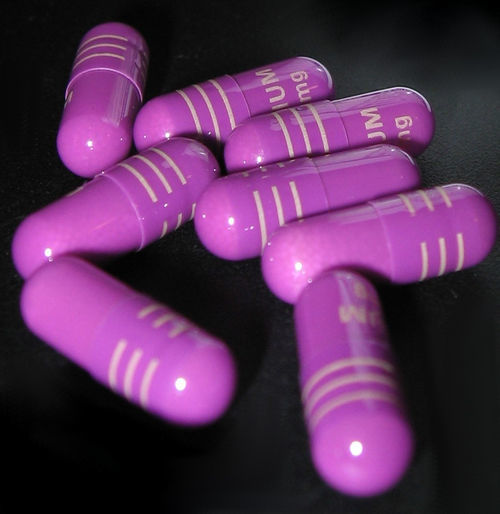Nexium lawsuits are personal injury claims against major pharmaceutical companies for the serious side effects of the stomach acid pill, Nexium. This drug has been linked to a severe risk for kidney disease and potentially fatal renal failure.
Despite the risks, Nexium has been aggressively marketed by drug companies, anyway. Worse, these marketing campaigns have glossed over or completely ignored the risks associated with taking Nexium over the long term.
In this article, our defective drug lawyers explain how Nexium works and the side effects that it has been associated with. The article will then delve into the lawsuits currently pending against the makers of Nexium (as part of the broader set of PPI lawsuits) before discussing how you can recover compensation if you have been hurt, as well.
- 1. How Nexium works
- 1.1. Nexium’s relationship with Prilosec
- 2. Side effects of Nexium
- 3. “Failure to warn” lawsuits over complications associated with Nexium
- 4. Multidistrict litigation (MDL) for Nexium lawsuits
- 5. What to do if you have been hurt by Nexium’s side effects
- 6. Call our defective drug lawyers if you have been hurt by Nexium

1. How Nexium works
Nexium is a proton pump inhibitor, or PPI. PPIs work by reducing the amount of hydrochloric acid produced and secreted in a patient’s stomach. They are frequently used to treat or prevent the following medical conditions:
- Acid reflux disease,
- Erosive esophagitis,
- Peptic ulcers,
- Zollinger-Ellison syndrome, an underlying condition that leads to peptic ulcers,
- Gastric ulcers, particularly for patients who need nonsteroidal anti-inflammatory drugs (NSAIDs), and
- Gastrointestinal ulcers that are associated with Chron’s disease.
Because many of these conditions are very common, PPIs are among the most prescribed drugs in the world.
Nexium is a popular proton pump inhibitor for several reasons:
- It is relatively inexpensive, at less than a dollar per pill,
- It can be taken orally, in pill form, as well as by injection,
- It is widely available, and
- It can be bought over-the-counter, without a prescription.
1.1. Nexium’s relationship with Prilosec
Both Nexium and the drug Prilosec**LINK** are proton pump inhibitors, and both were created and marketed by the pharmaceutical company AstraZeneca.
Prilosec was first sold in the U.S. in 1989. Its American patent expired in 2001, allowing other drug makers to copy Prilosec and sell generic versions of the drug.
Because generic versions of Prilosec drastically cut into AstraZeneca’s profits, the pharmaceutical company created a new drug, Nexium, to “replace” Prilosec as its PPI of choice. Nexium, however, is chemically identical to Prilosec in all ways but one – their chemical structures are mirror images of one another.
Despite the similarities between Prilosec and Nexium, the United States Food and Drug Administration (FDA) approved Nexium for medical use in 2000.1 The approval of Nexium effectively allowed AstraZeneca to continue to make money off its Prilosec drug formula, albeit under a different name.
2. Side effects of Nexium
Nexium has been associated with numerous side effects. The most common are relatively minor, and include:
- Headaches,
- Fever,
- Fatigue,
- Nausea,
- Abdominal and stomach pain,
- Chronic stomach inflammation,
- Chest pain,
- Elevated heart rate,
- Hypomagnesemia,
- Diarrhea,
- Gas,
- Constipation,
- Sore throat,
- Dry mouth, and
- A decreased appetite.
However, Nexium has also been linked to several side effects that are more severe:
- An increased risk of hip fractures,2
- An increased risk of coronary artery disease, when taken with blood thinners,3
- Pneumonia,4 and
- Chronic kidney disease and renal failure.5
The potential risks for chronic kidney disease and renal failure become are not small – studies have found that people who take PPIs, including Nexium, were up to 50% more likely to develop chronic kidney disease than those who did not take PPIs.6
Worse, those dangers grow exponentially as people use Nexium for longer periods of time. Nexium, after all, was intended as a short-term treatment for stomach acid problems, not as a long-term solution. One study indicated that people who took PPIs for between 31 and 90 days were nearly twice as likely to develop chronic kidney disease than those who did not use PPIs, while those who used a PPI for longer than 90 days were more than twice as likely to get a chronic kidney disease or renal failure.7
Nevertheless, Nexium has been marketed as a cure-all for stomach acid issues and acid reflux disease, with no mention of the dangers it poses to people who take the drug for longer periods of time.

3. “Failure to warn” lawsuits over complications associated with Nexium
The damage that Nexium has caused to patients’ kidneys and the potential for renal failure has led to lawsuits being filed against Nexium’s creator, AstraZeneca, and over-the-counter marketer, Pfizer. These lawsuits have focused on the fact that Nexium’s creators and marketers did not disclose or adequately warn patients about the significant potential for chronic kidney disease or renal failure that came with taking Nexium.
Drug companies have a legal duty to disclose the potential negative impacts and side effects of their drugs. Because potential patients rely on these disclosures to make an informed medical decision, the law requires drug companies to warn about the dangers associated with their products, or face liability for injuries caused by that non-disclosure.
While medical researchers were aware of the connection between proton pump inhibitors and kidney problems since the 1990s,8 AstraZeneca and Pfizer have refused to acknowledge it. Warning of the potential for serious kidney disease and even life-threatening renal failure would damage sales of Nexium, so they continue to market Nexium as a safe treatment for acid reflux.
4. Multidistrict litigation (MDL) for Nexium lawsuits
Because Nexium’s side effects and its connection to kidney problems are likely to have hundreds or even thousands of similar victims across the country, a multidistrict litigation (MDL) was created for the Nexium lawsuits in the District Court of New Jersey.9
This MDL consolidates all of the personal injury claims for kidney disease or renal failure against AstraZeneca and Pfizer into the district court in New Jersey for pretrial procedures, like discovery and summary judgment motions.
5. What to do if you have been hurt by Nexium’s side effects
If you think you have suffered from Nexium’s side effects, the first thing to do is talk to your doctor and ask about the effects of Nexium on your kidneys. The damage that proton pump inhibitors do to your kidney does not create the fever, rash, and eosinophilia that usually come with kidney damage. Without these signs of kidney problems, few doctors correctly diagnose kidney disease or even think to look for it.
Seeking prompt medical attention is also very important: The longer you take PPIs like Nexium, the most at-risk you are for developing chronic kidney disease or renal failure. Seeing a doctor quickly can get you off Nexium and onto an alternative stomach acid treatment plan before too much damage is done.
If you have been hurt and it looks like Nexium’s side effects are the cause of your injuries, seeing a lawyer can be a wise next step. Lawsuits related to Nexium’s side effects and the kidney problems that they cause are already in motion. Furthermore, the multidistrict litigation that has consolidated Nexium claims can streamline the process of recovering the compensation you deserve.
This compensation can include:
- Past medical expenses associated with your recovery from Nexium’s side effects,
- Future medical expenses you are likely to accrue as you continue to recover,
- Wages lost or other income you missed while you recover,
- Future difficulties at work and your reduced earning capacity from your injuries, and
- Compensation for your physical pain and mental suffering.
Discussing your legal options with a lawyer is best done soon after an injury, though. The statute of limitations forces you to take prompt action – usually within two years of your injuries – and lawsuits take time to put together.
6. Call our defective drug lawyers if you have been hurt by Nexium

The mass tort and defective drug lawyers at the Shouse Law Office represent the victims of poorly designed drugs like Nexium, helping them recover the compensation they need. Contact us online or call our law office for the legal representation you need to get the compensation you deserve.
Legal References:
- FDA Approval Letter for Nexium.
- Yang YX, Lewis JD, Epstein S, Metz DC, “Long-term proton pump inhibitor therapy and risk of hip fracture,” JAMA 296(24):2947-53 (December 27, 2006).
- Niu Q, Wang Z, Zhang Y, Wang J, Zhang P, Wang C, Yin X, Hou Y, “Combination Use of Clopidogrel and Proton Pump Inhibitors Increases Major Adverse Cardiovascular Events in Patients With Coronary Artery Disease: A Meta-Analysis,” Journal of Cardiovascular Pharmacology and Therapeutics 22(2):142-52 (March 22, 2017).
- Herzig SJ, Howell MD, Ngo LH, Marcantonio ER, “Acid-suppressive medication use and the risk for hospital-acquired pneumonia,” JAMA 301(20):2120-8 (May 27, 2009).
- Benjamin Lazarus, MBBS, Yuan Chen, MS, Francis P. Wilson, MD, MS, Yingying Sang, MS, Alex R. Chang, MD, MS, Josef Coresh, MD, PhD, and Morgan E. Grams, MD, PhD, “Proton Pump Inhibitor Use and Risk of Chronic Kidney Disease,” JAMA Internal Medicine 176(2):238-46 (February 1, 2016).
- See note 5.
- Yan Xie, Benjamin Bowe, Tingting Li, Hong Xian, Sumitra Balasubramanian and Ziyad Al-Aly, “Proton Pump Inhibitors and Risk of Incident CKD and Progression to ESRD,” Journal of the American Society of Nephrology, 27(10):3153-63 (October 2016).
- See Ruffenach SJ, Siskind MS, Lien YH, “Acute interstitial nephritis due to omeprazole,” American Journal of Medicine 93(4):472-3 (October 1992).
- MDL 2789, In Re: Proton-Pump Inhibitor Products Liability Litigation.
